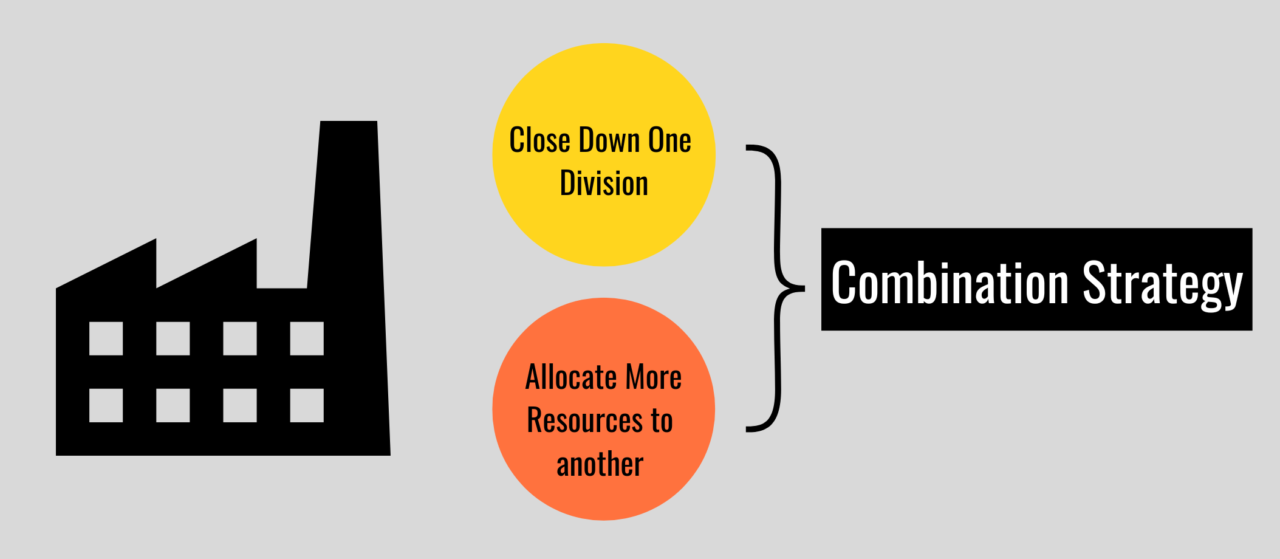Last updated on October 23rd, 2024 at 02:41 pm
Combination Strategy Meaning
Let’s say a company which manufactures men’s inner wear and also manufactures swimming gear. The company decided to expand its portfolio from men’s inner wear to woman inner wears. At the same time the company stopped its swimming wear division. This is nothing but the combination strategy or multiple strategies applied at one go.

Why Companies use Combination Strategy?
So, first of all any strategy in any company you would not use because such a strategy is available. However, the business dynamics might be such that it requires you to use multiple strategies all at once. Generally speaking this kind of strategy is usually required when
- the organization is large in size and complex.
- It can also be possible that the parent organization might have different kinds of industries that each business line caters to.
Example -1
Scenario:
Let’s suppose a company manufactures paint, at the same time to compete with other players it also manufactures adhesives. While since they are already in the paint business, they also have a leakage sealant product.
Strategy Used?
Now let’s suppose that they notice that over the years their sealant product has been eating up a lot of resources. While not really gaining any significant market share. On the other hand their adhesives business has been growing very well but less resources have been allocated to it. So the company decides to do the following;
- Keep the paint business stable
- Allocate more resources to adhesives(Expand)
- Shit down the leakage sealant division(retrenchment)
Hence in the above situation the company has used multiple strategies, which is nothing but combination strategy.
Example 2- ITC
ITC which is a diversified conglomerate, which was started in 1910 has fmcg, hotels, agribusiness , IT etc. Firstly it diversified into hotel business in 1975, adopted backward integration in 1925 but at the same time later the company divested its financial services business.
Example 3: Thermax
Thermax is a big name in India, which has used multiple combination strategies to survive and grow.
- Intially the company started with making coil type packager boiler and thermic fluid heaters
- Later the company diversified into energy conservation equipments, pollution control.
- In 2000 the company faced a loss for the first time and the company divested from non core sectors like electronics, software and focused on expanding internally.
Types of Combination Strategy
| Types | Simultaneous combination strategy | Sequential Combination Strategy | Combination of both |
| Example | Divesting a product divison while incorporating it into another division | Intially using growth then stable | Using both |
| Used when | Turnaround scenarios | Multiple scenarious like turnaround, start ups etcs | |
| Why is it used | When company is experimenting for new growth | When company is less on resources |
Retrenchment Versus Combination Strategy
The same example of thermax where it initially was into steam generation boiler’s business, but then later on diversified into multiple industries. However, rarely will you see that all the industries will work profitably and as plannd. So during years when the business is put under pressure, the company may retrench or reduce its divisions to focus their resources on certain industries only. Examples include, turnaround, divestment,liquidation or captive strategy.
On the other hand the combination strategy is used when the company sees that it requires stability on one hand. While, at the same time use some of those resources to experiment to find newer opportunities. Examples include simultatenous, sequential combination strategies.
Frequently Asked Questions(FAQ’s)
What are retrenchment strategies?
Retrenchment strategies as the name suggest reducing, is employed by companies to reduce their certain business divisions if they are profitable. Examples include situations where the company is making a loss. So may be the company needs a turaround strategy.
What type of strategy is stable strategies?
Stable strategies is an enterprise level strategies used when the company has already gained market share in its industry and wants to hold that market strategy. This is different from an expansionary strategy where the focus is on growth.


